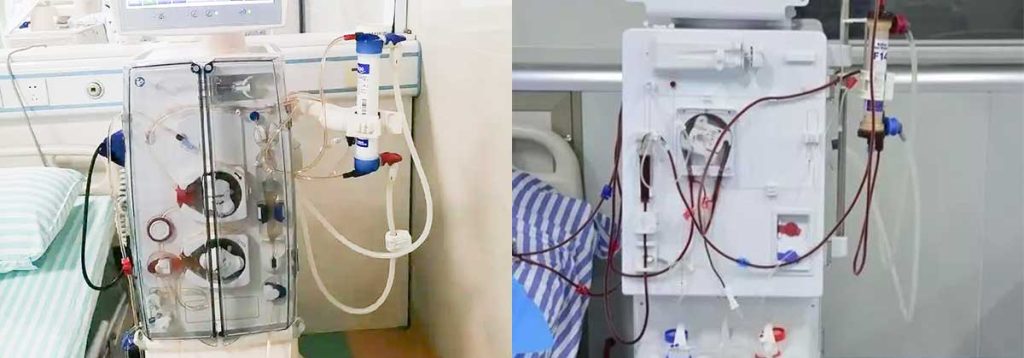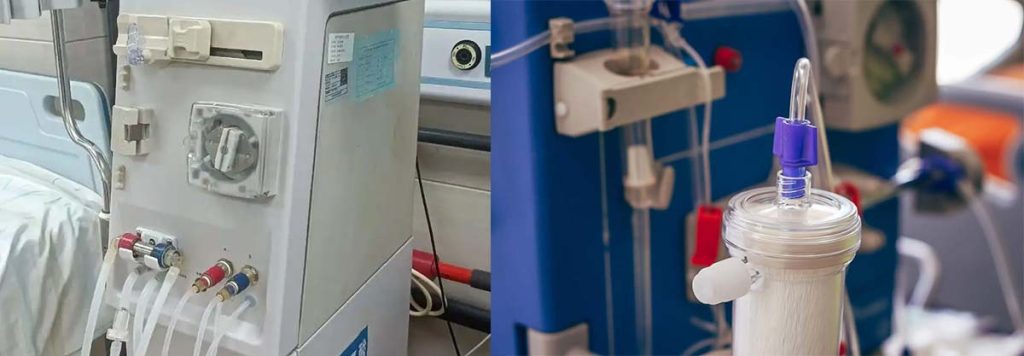

Diffusion in dialysis describes the movement of molecules from areas of higher concentration to lower concentration through a semipermeable membrane. This process allows the removal of small solutes like urea, creatinine, and electrolytes, which are harmful in excess. For instance:
- Hemodialysis efficiently reduces high urea levels in uremic patients.
- Dialyzer membranes, such as FINEFLUX, influence solute clearance, with maltodextrin clearance being diffusion-controlled.
- Urea clearance depends on flow control, highlighting the complexity of solute transport.
Studies using MRI have also demonstrated diffusion’s role in mimicking kidney filtration, validating its importance in detecting kidney fibrosis and assessing renal health.
Key Takeaways
- Diffusion in dialysis cleans the blood by moving waste from high to low concentration through a special filter.
- Knowing how concentration works is important; a bigger difference makes diffusion faster, helping remove toxins better during dialysis.
- The special filter lets small waste pass but keeps important proteins in the blood, keeping things balanced.
- Changing the dialysate mix can control electrolyte levels, stopping problems that might harm health.
- New tools, like tiny probes, try to make diffusion work better, improving dialysis treatments overall.
Understanding Diffusion in Dialysis
What Is Diffusion in Dialysis?
Diffusion in dialysis refers to the movement of solutes across a semipermeable membrane. This process occurs due to random molecular motion, allowing substances to move from areas of higher concentration to areas of lower concentration. It plays a vital role in removing toxins and waste products from the blood. For example, urea and creatinine, which accumulate in the bloodstream, diffuse into the dialysate during dialysis. Recent research highlights that this process is thermodynamically favorable, ensuring efficient toxin removal.
The semipermeable membrane used in dialysis allows small molecules like urea to pass through while restricting larger molecules such as proteins. This selective permeability ensures that essential components remain in the blood while harmful substances are removed.
The Role of Concentration Gradients in Diffusion
Concentration gradients drive diffusion in dialysis. Molecules naturally move from areas of higher concentration to areas of lower concentration until equilibrium is reached. For instance, during dialysis, waste products in the blood diffuse into the dialysate because the dialysate has a lower concentration of these substances.
Quantitative studies demonstrate the impact of concentration gradients on molecular movement. For example, as sucrose concentration increases, the mass change in dialysis bags becomes more negative. This indicates that water moves out of the bags into the surrounding solution, driven by the concentration gradient.
| Sucrose Concentration | Mass Change (%) |
|---|---|
| Distilled water | 15.93% |
| 0.2M sucrose | -2.77% |
| 0.4M sucrose | -16.55% |
| 0.6M sucrose | -22.83% |
| 0.8M sucrose | -25.72% |
| 1.0M sucrose | -28.17% |
This data highlights how concentration gradients influence diffusion efficiency in dialysis.
How Semipermeable Membranes Work in Dialysis?
The semipermeable membrane is a critical component of dialysis. It contains tiny pores that allow molecules below a certain size to pass through while blocking larger ones. This size-based diffusion ensures that waste products like urea and excess electrolytes leave the blood, while proteins and other essential molecules remain.
The membrane’s selective permeability also enables the diffusion of essential minerals into the blood when needed. For example, if the blood lacks potassium, the dialysate can be adjusted to allow potassium to diffuse into the bloodstream. This adaptability ensures that dialysis not only removes toxins but also helps maintain the body’s electrolyte balance.
Note: The effectiveness of a semipermeable membrane depends on its pore size and material. Advances in membrane technology continue to improve diffusion efficiency, enhancing the overall effectiveness of dialysis.
Principles of Diffusion in Dialysis
The Science Behind Diffusion in Dialysis
The principle of diffusion explains how molecules move from areas of higher concentration to lower concentration. In dialysis, this process occurs across a semipermeable membrane, enabling the removal of waste products like urea and creatinine from the blood. Scientific studies have explored the mechanisms driving diffusion in dialysis. For example, research on microdialysis mass transfer has shown how concentration gradients and mass transfer resistance influence molecular movement. The study also highlights the role of flow rates in enhancing diffusion efficiency, which is critical for effective toxin removal. These findings provide valuable insights into the science behind diffusion in dialysis.
Factors Influencing Diffusion Efficiency

Several factors affect the efficiency of diffusion in dialysis. The concentration gradient between the blood and the dialysate plays a significant role. A steeper gradient increases the rate of diffusion, allowing waste products to move more rapidly into the dialysate. The flow rate of both the blood and the dialysate also impacts diffusion. Faster flow rates can enhance the removal of toxins by maintaining a strong concentration gradient.
The properties of the semipermeable membrane further influence diffusion efficiency. Membranes with optimal pore sizes allow small molecules to pass through while retaining larger ones. Temperature is another factor, as higher temperatures can increase molecular movement, improving diffusion rates. Understanding these factors helps optimize the principles of dialysis for better patient outcomes.
The Importance of Equilibrium in Dialysis
Equilibrium is a key concept in diffusion. During dialysis, molecules move until their concentrations equalize on both sides of the semipermeable membrane. This balance ensures that waste products are effectively removed from the blood while essential substances remain. For instance, if the concentration of urea in the blood decreases to match that in the dialysate, the diffusion process slows down.
Maintaining equilibrium is vital for the safety and effectiveness of dialysis. Adjusting the composition of the dialysate can help achieve this balance. For example, adding specific electrolytes to the dialysate can prevent excessive removal of these substances from the blood. This careful regulation ensures that dialysis supports the body’s natural balance while removing harmful toxins.
Applications of Diffusion in Dialysis
Removing Waste and Toxins from the Blood
Diffusion in dialysis plays a crucial role in eliminating harmful substances from the bloodstream. Waste products like urea and creatinine accumulate in the blood when the kidneys fail to function properly. During dialysis, these molecules move across the semipermeable membrane into the dialysate, where their concentration is lower. This process ensures that toxins are effectively removed, reducing the risk of complications such as uremia. By mimicking the natural filtration process of the kidneys, diffusion helps maintain the body’s internal environment and prevents the buildup of dangerous substances.
Regulating Electrolytes and Fluid Balance
Electrolyte and fluid imbalances can lead to severe health issues, including muscle weakness, irregular heart rhythms, and swelling. Dialysis addresses these problems by using diffusion to regulate the levels of electrolytes like sodium, potassium, and calcium in the blood. For example, if potassium levels are too high, the dialysate is adjusted to create a concentration gradient that allows excess potassium to diffuse out of the blood. Similarly, diffusion helps remove excess fluid by drawing water molecules across the membrane, restoring proper hydration levels. This precise control of electrolytes and fluids is vital for maintaining overall health.
Supporting Overall Health During Dialysis
The benefits of diffusion extend beyond waste removal and electrolyte regulation. By maintaining a stable internal environment, dialysis supports the body’s overall health. Proper diffusion ensures that essential nutrients and minerals remain in the blood while harmful substances are removed. This balance helps patients feel better and reduces the risk of complications associated with kidney failure. Advances in dialysis technology continue to improve the efficiency of diffusion, enhancing the quality of life for individuals undergoing treatment.
Benefits and Challenges of Diffusion in Dialysis
Advantages of Diffusion in Dialysis
Diffusion in dialysis offers several benefits, particularly in removing toxins and maintaining the body’s balance. This process effectively eliminates waste products like urea and creatinine, which accumulate in the blood due to kidney failure. By mimicking the natural filtration function of the kidneys, diffusion helps prevent complications such as uremia and electrolyte imbalances.
Clinical studies comparing different dialysis methods highlight the effectiveness of diffusion. For instance, expanded hemodialysis (HDx) demonstrates higher toxin removal efficiency than conventional methods. Online hemodiafiltration (HDF) also shows significant cardiovascular benefits in some cases. However, HDx offers a more advanced approach to toxin clearance.
| Aspect | Online Hemodiafiltration (HDF) | Expanded Hemodialysis (HDx) |
|---|---|---|
| Effectiveness in removing toxins | High | Higher than conventional HD |
| Cardiovascular benefits | Some studies show improvement | Uncertain compared to others |
| Challenges | High cost, technical burden | Unknown cardiovascular benefits |
These findings emphasize the importance of diffusion in improving patient outcomes during dialysis.
Limitations and complementary processes
Despite its advantages, diffusion has limitations. It primarily removes small molecules, leaving larger toxins and proteins unaffected. This limitation necessitates complementary processes like convection, which can target larger molecules.
Studies on complementary and alternative medicine (CAM) approaches, such as Reiki, reveal limited evidence of their efficacy in managing pain for dialysis patients. The complexity of dialysis patients, who often have multiple health conditions, makes it challenging to tailor treatments effectively.
| Evidence Type | Description |
|---|---|
| Efficacy of CAMs | Limited evidence on the efficacy of Reiki and related CAMs in pain management for dialysis patients. |
| Study Population | Dialysis patients are complex and heterogeneous, often with high comorbidity, making tailored efficacy studies rare. |
| Search Strategy | A broader search on Pubmed and CINAHL retrieved relevant studies, including a Cochrane review and recent RCTs on Reiki and chronic pain. |
These insights highlight the need for a multifaceted approach to address the limitations of diffusion in dialysis.
Innovations to Enhance Diffusion Efficiency

Recent innovations aim to improve diffusion in dialysis. Microdialysis probes using electroosmosis represent a promising development. These probes enhance control over substance concentrations, reducing tissue trauma and improving measurement accuracy.
| Feature | Description |
|---|---|
| Innovation | Microdialysis probes using electroosmosis to enhance diffusion efficiency. |
| Key Advantage | Improved control over substance concentrations, minimizing tissue trauma. |
| Measurement Capabilities | Can measure natural concentrations and effects of various substances on concentrations. |
| Current Development Stage | In vivo data stage of development. |
These advancements demonstrate the potential for technology to address existing challenges and improve the overall effectiveness of dialysis.
Conclusion
Diffusion remains a fundamental process in dialysis, ensuring the removal of harmful substances and maintaining the body’s internal balance. By utilizing concentration gradients and a semi-permeable membrane, dialysis effectively replicates the filtration function of healthy kidneys.
Research highlights the broader impact of diffusion on patient health. For example, studies on hemodialysis patients reveal significant white matter damage in anterior brain regions, indicating accelerated aging effects.
| Finding | Description |
|---|---|
| White Matter Damage | Hemodialysis patients show more disease in anterior brain regions. |
| Fractional Anisotropy | Lower FA observed in fronto-temporal connections and the corpus callosum. |
| Mean Diffusivity | Higher diffusivity in anterior brain regions, indicating white matter damage. |
Long-term studies also demonstrate the effectiveness of diffusion in improving survival outcomes. High-volume hemodiafiltration, with convection volumes exceeding 22 L/session, significantly enhances patient survival rates. These findings underscore the critical role of diffusion in dialysis, improving both health and quality of life for dialysis patients.
